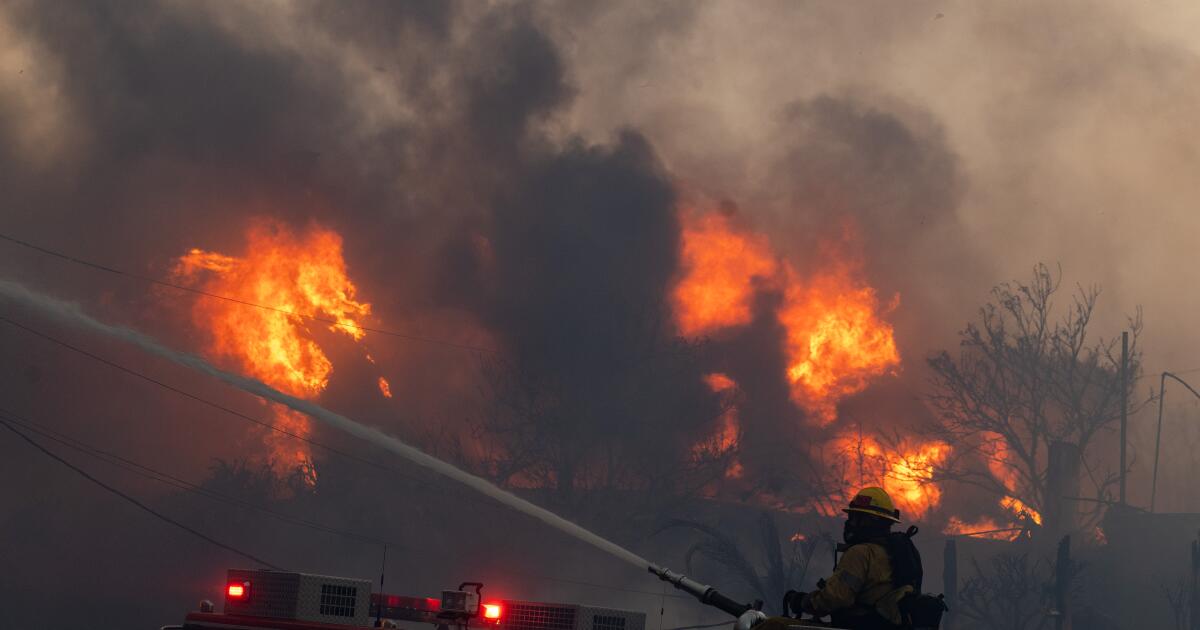Citing wildfires, LAFD requests 15% budget increase
The Los Angeles Fire Department is requesting a budget of more than $1 billion for the coming year, arguing that the additional funding is necessary to be prepared for wildfires like the one that devastated Pacific Palisades in January.
The request, which represents a more than 15% increase over this year’s budget, includes money for 179 new firefighting recruits and a second crew dedicated to fighting wildfires, as well as helitanker services to battle fires from the air.
In the immediate aftermath of the Palisades fire, which killed 12 people and destroyed thousands of homes, top LAFD officials blamed a lack of resources and extraordinarily high winds for their failures in combating the flames.
United Firefighters of Los Angeles City Local 112, the union that represents the city’s firefighters, has long argued that the department is severely underfunded and is pushing for a half-cent sales tax that, if approved by voters, would generate hundreds of millions of dollars annually.
Fire Chief Jaime Moore, who was appointed to his post earlier this month, wrote in a memo to the Board of Fire Commissioners last Friday that “the proposed budget will reinforce and accelerate operational enhancements implemented following the devastating Palisades wind-driven vegetation fire in January 2025.”
Moore’s request is the first step in a lengthy process to hammer out a city budget that requires approval by the City Council and the mayor. This year, the city had to close a nearly $1-billion shortfall caused largely by rising personnel costs, soaring legal payouts and a slowdown in the local economy.
City department heads often request amounts far higher than they eventually receive. With the city still in a budget crunch, the outlook for the LAFD’s request is unclear.
“The budget process is in its early stages. Reforms must continue to be implemented at the department and Mayor Bass looks forward to working with Chief Moore to strengthen the city’s emergency preparedness,” said Clara Karger, a spokesperson for Mayor Karen Bass.
Genethia Hudley Hayes, who heads the civilian Board of Fire Commissioners, said Tuesday that she had not yet seen the request but that she generally supports a 15% increase in the LAFD budget.
“We need it,” she said. “The smart thing would be to let the public know what you are going to do with that money.”
In the days leading up to Jan. 7, LAFD officials decided not to order firefighters to remain on duty for a second shift — which would have required paying them overtime — and staffed just a few of the more than 40 engines available to aid in battling wildfires, despite warnings of life-threatening winds, a Times investigation found.
Then-Fire Chief Kristin Crowley said that commanders had to be strategic with limited resources while continuing to handle regular 911 calls.
An LAFD after-action report released last month cited “financial constraints” as a factor in pre-deployment decisions.
The Times also found that an LAFD battalion chief ordered firefighters to leave the site of the Jan. 1 Lachman fire, despite firefighters’ complaints that the ground was still smoldering. That fire later reignited into the Palisades fire.
Moore’s budget memo tied many of his requests to the Palisades fire.
The second wildland hand crew, which would include 32 positions for $2 million, would supplement a hand crew formed this year, after the Palisades fire. The crew’s 26 recruits, who are trained in wildfire fighting and management, establish fire lines to stop flames from spreading. Throughout the year, they do brush clearance around the city.
The helitanker lease, costing slightly less than $1 million, would support aerial attacks of flames that are difficult for crews on the ground to reach.
Moore’s budget request includes the reinstatement of the LAFD’s emergency incident technicians, who help coordinate responses to fires — positions that were cut in the last budget cycle. The after-action report described the LAFD’s disorganized response to the Palisades fire, citing major issues with staffing and communications.
In the fire’s aftermath, the LAFD’s budget was a subject of public debate, with some saying that Bass had reduced it. The 2024-25 budget actually increased slightly after firefighters received raises and the city invested in new firetrucks and other purchases. The budget increased again in 2025-2026.
Bass said she has committed additional resources to the Fire Department in each year she has been mayor.
The half-cent sales tax proposed by the firefighters union would go before city voters as a ballot measure next November.
By 2050, the sales tax would raise at least $9.8 billion, funding at least 30 new fire stations and new fire trucks, as well as adding 1,400 Fire Department employees, according Doug Coates, the acting president of UFLAC, and Councilmember Traci Park, whose district includes Pacific Palisades.

